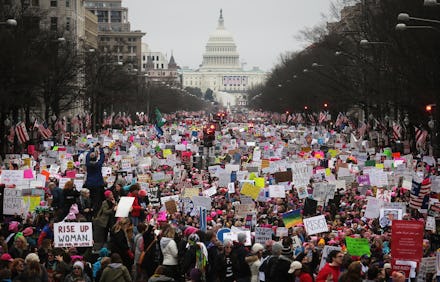Donald Trump and Women's Marches: How 48 hours of power and protest will define the next four years

How we will remember this weekend
The past two days offered one of the starkest contrasts in American history. Donald Trump's swearing-in as president attracted tons of supporters, but seemingly far fewer than Barack Obama's first inauguration. The peaceful transfer of power to Trump was a moment of triumph to some and a sign of horror to others. The latter group coalesced into the resistance to Trump throughout the weekend.
On Friday, security forces came out in numbers, and Black Lives Matter participated in a coalition effort to disrupt the proceedings — and succeeded for a time. That protest and others set a confrontational tone that continued late into the night.
On Saturday, people turned out en masse as part of the Women's March on Washington — an impressive feat for novice organizers. They flooded not only the nation's capital, but cities around the world, with an estimated total of 2.5 million people not quite protesting Trump, but spurred to action under the banner of women's rights by his election nonetheless. It was an unprecedented start to an unprecedented sort of president.
Buckle up: The Donald Trump era is here — and it has been met by what one expert says is the largest protest in American history.
Policy, meanwhile, was being made at 1600 Pennsylvania Ave. In the hours after he was sworn in, Trump's team signaled some shifts in American policy on issues from climate change to LGBTQ rights. One of his first executive orders minimized the efficacy of the Affordable Care Act, and he added gold drapes in the Oval Office. He raised mortgage bills for first-time homebuyers. The White House sent the Senate a list of official nominations for Cabinet posts, ambassadorships and other positions. And on Saturday, he visited the CIA to say he fully supported America's intelligence agencies — after feuding with them for months over their conclusions about the role Russian hacking played in the 2016 election.
Trump's critics internationally used Saturday's massive Women's March on Washington to send a deafening message: We will resist. The day after a small number of protesters in D.C. burned vehicles and broke windows, hundreds of thousands of peaceful marchers descended on the capital. Numerous celebrities, politicians, activists and others spoke at the Washington, D.C., women's march. Madonna said she has thought about burning down the White House. Janelle Monáe chanted the names of black men killed by police. And in New York City, Los Angeles, Chicago, Seattle, Atlanta and many more cities worldwide, images of streets flooded with marchers filled television screens. The grassroots opposition to Trump, and the views he espoused during his campaign, could not be ignored. And that is a major problem for Republicans.
As of Friday, Trump holds the greatest institutional power in the world. But protesters showed they have the ability to organize at mass scale, demonstrating a different kind of power. The biggest question between now and 2020: Will that energy be converted into votes?
This is Mic's daily read on Donald Trump's America — and how it affects you. Welcome to the political newsletter that walked many miles in Washington D.C. the past two days.Want to receive this as a daily email in your inbox? Subscribe here.
Imagery from Trump's America
Here are six of the best shots of inaugural festivities, protests and the Women's March from Mic photographer Quincy Ledbetter.
The Mic stories you need to read:
• Nine aerial photos demonstrate the scale of simultaneous women's marches around the world. At least one million people marched in the U.S.
• Elections have consequences — here are the ways Trump changed America within hours of taking office.
• ProPublica and the Washington Post signal Trump has yet to do the bare minimum to make good on his promise to leave the management of his companies.
• Trump deleted a tweet. But now that he's president, that may be illegal.
• Mic's most read story from Saturday: 14 powerful photos that show the unity of women's marches around the world.
• There were no Muslim leaders at Trump's inauguration. Mic explains the significance of their absence.
• Police said they did not use stun grenades on protesters Friday. Video and photos prove otherwise.
• "I still have hope for change. I'm here to resist." Men at the Women's March in Washington explain why they marched. Will the Women's March finally unite the Left?
• The view from inside the inauguration: How Trump supporters reacted to the new president.
• The Women's March cements unity after the inauguration.
More news to monitor:
• Press Secretary Sean Spicer gave his first briefing Saturday evening, and it was a doozy. Spicer openly lied about the size of Trump's inauguration, calling it "the largest audience to ever witness an inauguration, period." Visual evidence contradicts that statement, but it didn't stop Spicer's scolding of the press from the White House briefing room.
• James "Mad Dog" Mattis was confirmed by the Senate on Friday. He is Trump's first confirmed cabinet member.
• Citing ethics concerns, Betsy DeVos' confirmation process has been postponed. She delivered a widely criticized performance in her hearing last week.
• Trump stood in front of a wall dedicated to Americans who died serving their country and lied about the size of attendance at his inauguration.